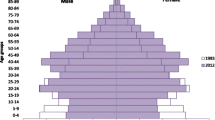Abstract
Since the new round of health system reform, the annual average growth rate of health expenditure in real term in China was 10.5%, which is much faster than that of any other Asian countries. The aim of this study is to analyze major effecting factors include population ageing’s contribution to health expenditure growth, as population ageing is accelerating and considered as a major driver of health expenditure growth in China. A component based health expenditure model was developed in this study and five major factors were employed, namely population size, population structure, disease prevalence rate, excess health price inflation (EHPI) and expenditure per prevalent case. Then Das Gupta’s decomposition method was applied to decompose the health expenditure growth into the five factors. Results shows that expenditure per prevalent case was the major factor, which accounted for 59.6% of the health expenditure growth. 21.2% of the health expenditure growth was driven by population ageing, followed by EHPI (11.2%), population growth (5.4%) and disease prevalence rate (2.6%). Population ageing affected circulatory diseases the most, which caused 5.2% of the difference in health expenditure, followed by neoplasms (2.9%), respiratory diseases (2.0%), digestive diseases (1.8%), and endocrine (1.5%). Our work highlights that measures should be taken to reduce risk factors of major non-communicable disease to promote healthy ageing, and it is fundamental to address growth in expenditure per case, especially for circulatory, respiratory, digestive, genitourinary diseases, and endocrine, nutritional and metabolic to contain the rapid health expenditure growth in China.


Similar content being viewed by others
References
Chen, H., Huang, C., & Chen, Z. (2009). Effects of three factors on total health care expenditure. Journal of Harbin Institute of Technology,41(12), 317–320.
China National Center for Cardiovascular Diseases. (2019). China report on cardiovascular disease in China 2018. Beijing: Encyclopedia of China Publishing House.
China National Health Development Research Center. (2019). China national health accounts report 2019. Beijing: China National Health Development Research Center.
Das Gupta, P. (1993). Standardization and decomposition of rates: A user's manual. In U.S. Bureau of the Census (Ed.), Current population reports (pp. 23–186). Washington, DC: U.S. Government Printing Office.
de Meijer, C., Wouterse, B., Polder, J., & Koopmanschap, M. (2013). The effect of population aging on health expenditure growth: A critical review. European Journal of Ageing,10(4), 353–361. https://doi.org/10.1007/s10433-013-0280-x.
Global Burden of Disease Collaborative Network, Global Burden of Disease Study 2017 (GBD 2017). 2017. Results. Seattle, United States: Institute for Health Metrics and Evaluation (IHME), 2018. https://ghdx.healthdata.org/gbd-results-tool.
Li, Q., & Deng, D. (2017). New medical risks affecting obstetrics after implementation of the two-child policy in China. Frontiers in Medicine,11(4), 570–575.
Li, Y. (2008). A projection of China's health expenditures from today to 2050. (Master's), Institute of Health Management and Health Economics, Universitetet i Oslo, Oslo.
Liu, S., Zhou, H., & Peng, X. (2000). Ridge regression analysis on the effecting factors of total health expenditure. Health Economics Research,9, 12–14.
Ma, D., Sakai, H., Wakabayashi, C., Kwon, J. S., Lee, Y., Liu, S., et al. (2017). The prevalence and risk factor control associated with non-communicable diseases in China, Japan, and Korea. Journal of Epidemiology,27(12), 568–573. https://doi.org/10.1016/j.je.2016.12.019.
Morgan, S., & Cunningham, C. (2011). Population aging and the determinants of healthcare expenditures: The case of hospital, medical and pharmaceutical care in British Columbia, 1996 to 2006. Healthcare Policy,7(1), 68–79.
OECD. (2017). Health data at a glance 2017: OECD indicators. Paris: OECD Publishing.
Qi, H., Zhou, C., Xue, Q., Zheng, W., Wang, X., Guo, Z., et al. (2012). Analysis of effect factors of the total health expenditure of China. Chinese Health Economics,31(10), 13–15.
United Nations, Department of Economic and Social Affairs, Population Division (2019). World Population Prospects 2019, Online Edition.
Wang, C. (2018). Decomposition of factors affecting China’s per capita health expenditure growth. Insurance Studies,3, 118–127.
White, C. (2007). Health care spending growth: How different is the United States from the rest of the OECD? Health Affairs,26(1), 154–161. https://doi.org/10.1377/hlthaff.26.1.154.
Yang, Z., Norton, E. C., & Stearns, S. C. (2003). Longevity and health care expenditures the real reasons older people spend more. The Journals of Gerontology Series B: Psychological Sciences and Social Sciences,58(1), S2–S10. https://doi.org/10.1093/geronb/58.1.S2.
Zhai, T. (2017). Construction method and Practice of health service price index in China. Chinese Health Economics,36(1), 63–66.
Zhai, T., Goss, J., Dmytraczenko, T., Zhang, Y., Li, J., & Chai, P. (2019). China’s health expenditure projections to 2035: Future trajectory and the estimated impact of reforms. Health Affairs (Millwood),38(5), 835–843. https://doi.org/10.1377/hlthaff.2018.05324.
Zhai, T., Goss, J., & Li, J. (2017). Main drivers of health expenditure growth in China: A decomposition analysis. BMC Health Services Research,17(1), 185. https://doi.org/10.1186/s12913-017-2119-1.
Zweifel, P., Felder, S., & Meiers, M. (1999). Ageing of population and health care expenditure: A red herring? Health Economics,8(6), 485–496. https://doi.org/10.1002/(SICI)1099-1050(199909)8:6<485:AID-HEC461>3.0.CO;2-4.
Acknowledgements
We would like to thank Dr Yuhui Zhang and adjunct associate professor John Goss for all of their helpful efforts, without which this work would not have been possible. We are also grateful to the IHME for sharing prevalent case data utilized in this study.
Funding
There is no funding source of this research.
Author information
Authors and Affiliations
Corresponding author
Rights and permissions
About this article
Cite this article
Zhai, T., Wan, Q., Chai, P. et al. A decomposition analysis of recent health expenditure growth in China: is population ageing a significant effecting factor?. China popul. dev. stud. 4, 45–57 (2020). https://doi.org/10.1007/s42379-020-00058-2
Received:
Accepted:
Published:
Issue Date:
DOI: https://doi.org/10.1007/s42379-020-00058-2




